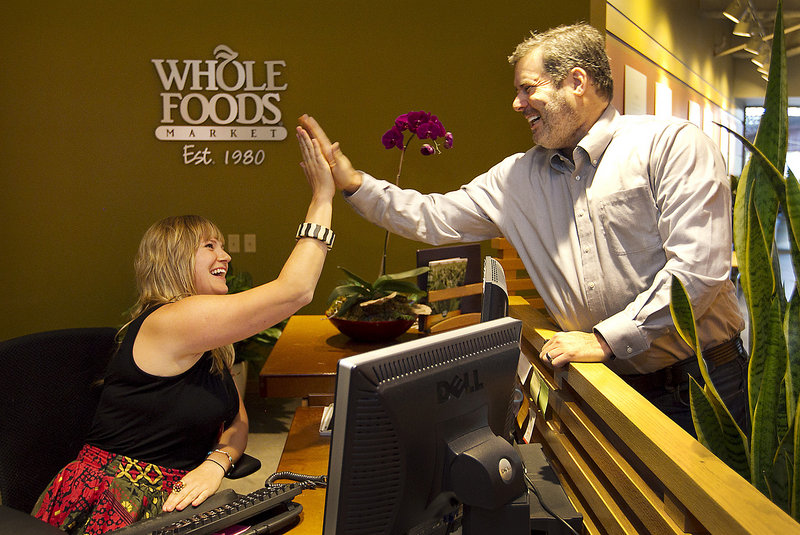AUSTIN, Texas — Nikki Newman and Mark Ehrnstein have plenty in common. They both work at Whole Foods’ headquarters, and they share a passion for the earth-friendly, healthy and egalitarian values the company espouses.
Ask them why they work at Whole Foods, and you get a lot of the same answers.
Ask them about their paychecks, though, and you get two different stories.
Newman, the receptionist at the company’s corporate offices, has worked for Whole Foods for six years and now makes about $17 an hour. She lives comfortably in a rented duplex, but she admitted money can get tight on occasion – like the time her dog needed a surprise $750 worth of dental care.
Ehrnstein, on the other hand, is Whole Foods’ global vice president for team member services, a position that pays him a six-figure annual salary. He and his wife, Renee, have worked more than 30 years combined at Whole Foods. They own a 3,151-square-foot home, according to Travis County Central Appraisal District records.
“I feel very grateful to be in the role I’m in, but most of all I feel grateful to work for a company that aligns with my values,” Ehrnstein said. “I feel connections with our team members in that sense. But certainly, the compensation affords different opportunities.”
This is not the stereotypical story of the gap between rich and poor. Few would criticize the wage disparity between Newman and Ehrnstein given their respective tenures and responsibilities at the company. Plus, the gap from top to bottom is much narrower at Whole Foods than other large grocers because it pays higher entry-level wages and caps executive pay at 19 times the salary of its lowest-paid employee.
Nationwide, though, wage inequality has expanded throughout the downturn. In 2009, one in four U.S. workers held jobs considered “low wage,” roughly $10.50 an hour or less at the time, according to a January report by John Schmitt, senior economist at the Center for Economic and Policy Research in Washington.
“If low-wage jobs act as a steppingstone to higher-paying work, then even a relatively high share of low-wage work may not be a serious social problem,” he wrote. “If, however, as appears to be the case in much of the wealthy world, low-wage work is a persistent and recurring state for many workers, then low-wages may contribute to broader income and wealth inequality and constitute a threat to social cohesion.”
The degree to which wage inequality contributes to the politically charged issue of income inequality is open to debate.
Non-wage income, such as investment gains, and a host of other factors – such as higher marriage rates among higher-income couples – tend to contribute more to expanding income disparity.
A recent study by Richard Florida, director of the Martin Prosperity Institute, found that wage inequality explained only about 15 percent of income inequality in 350 of the largest U.S. metro areas. Austin had the ninth-widest wage disparity out of those 350 areas, according to Florida’s report, yet its income inequality gap was significantly smaller.
The widening income gap is instead more closely related to capital markets than to skills and wages, said professor James Galbraith of the University of Texas’ Lyndon B. Johnson School of Public Affairs.
The ability to tap markets at the right time – getting into high-tech during the late 1990s instead of the early 2000s, for example – tends to generate more income disparity at the high end than wages.
That sort of income inequality isn’t necessarily a bad thing, Galbraith and other economists note. It’s a natural outcome in a capitalist society, and for many people, it can serve as a spur for economic attainment.
But on a national and global scale, income inequality can be a harbinger of oncoming crises, Galbraith said. He equates it to blood pressure – there’s a healthy range, and lower is better within that range, but serious problems can arise if you go too low or too high.
Concerns also increase when income inequality remains persistent in a period of economic stagnation, said Pia Orrenius, assistant vice president and senior economist at the Federal Reserve Bank of Dallas.
“If it’s a long-term, growing problem, it can’t be good for a free society like ours,” Orrenius said. “The whole American model is based on opportunity – to justify rich people because we say, ‘You, too, can be rich.’ If you take that away, the founding ideal is being questioned.”
Send questions/comments to the editors.



Success. Please wait for the page to reload. If the page does not reload within 5 seconds, please refresh the page.
Enter your email and password to access comments.
Hi, to comment on stories you must . This profile is in addition to your subscription and website login.
Already have a commenting profile? .
Invalid username/password.
Please check your email to confirm and complete your registration.
Only subscribers are eligible to post comments. Please subscribe or login first for digital access. Here’s why.
Use the form below to reset your password. When you've submitted your account email, we will send an email with a reset code.